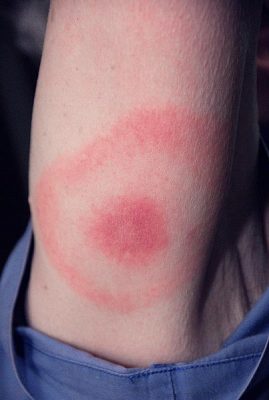 The oval skin lesion spreads circularly, and most often, it develops 1-2 weeks after the bite. It is up to 5 cm in diameter and in most cases, it is a sign of Lyme disease, so if it persists for at least three days, consult a general practitioner (GP) or dermatologist immediately,” the doctor suggests. According to her, the spots disappear on their own in a few weeks, so the disease goes unnoticed, and can cause neurological, heart or joint problems years or decades later. In such cases, it is very difficult to identify the root cause, after late complications have developed,” adds Dr. Anikó Kovács.
The oval skin lesion spreads circularly, and most often, it develops 1-2 weeks after the bite. It is up to 5 cm in diameter and in most cases, it is a sign of Lyme disease, so if it persists for at least three days, consult a general practitioner (GP) or dermatologist immediately,” the doctor suggests. According to her, the spots disappear on their own in a few weeks, so the disease goes unnoticed, and can cause neurological, heart or joint problems years or decades later. In such cases, it is very difficult to identify the root cause, after late complications have developed,” adds Dr. Anikó Kovács.
Another serious disease transmitted by tick bites is viral meningitis, which can affect anyone regardless of age. Unlike Lyme disease, there is no skin rash in this case. The first symptoms are headache and fever for 7-14 days after the bite, followed by dizziness, stiffness in the back of the neck and difficulty moving it. The disease is preventable by vaccination, which can be given from the age of one,” explains the clinician. If such symptoms occur, consult your GP or an infectologist immediately,” she adds.
 The tick must be removed carefully – preferably as soon as possible – using a tick spoon or tweezers, without crushing or injuring its body, as this is when the toxin enters the human body and then the bloodstream. Then disinfect the skin, and monitor the area for 1-2 weeks to see if any skin reaction develops. It is strictly forbidden to put oil, cream or powder on the tick, because this way, the animal can crawl out from under the skin, and in the meantime, involuntarily inject the toxin into the body,” says Dr. Anikó Kovács. It is also strictly forbidden to apply steroid creams to Lyme spots, as this will only make symptoms disappear more quickly, and the disease remains unnoticed.
The tick must be removed carefully – preferably as soon as possible – using a tick spoon or tweezers, without crushing or injuring its body, as this is when the toxin enters the human body and then the bloodstream. Then disinfect the skin, and monitor the area for 1-2 weeks to see if any skin reaction develops. It is strictly forbidden to put oil, cream or powder on the tick, because this way, the animal can crawl out from under the skin, and in the meantime, involuntarily inject the toxin into the body,” says Dr. Anikó Kovács. It is also strictly forbidden to apply steroid creams to Lyme spots, as this will only make symptoms disappear more quickly, and the disease remains unnoticed.
Ticks are most at home in taller grass and lower bushes, from where they cling onto our clothes and skin. Therefore, it is always a good idea to wear closed shoes, long trousers and long-sleeved outerwear when out and about, and to check your skin thoroughly when you get home.
Eszter Csatári-Földváry
Translation: Viktória Kiss
Cover photo (illustration): Pixabay/Erik Karits
Photo: Wikipedia


